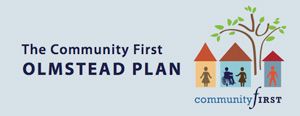
Olmstead Plan
Olmstead Plan
The Community First Olmstead Plan is a work in progress. The six goals provide a framework for ongoing and future work focused on achieving the mandate and the spirit of the Olmstead decision: people with disabilities across the lifespan have a right to live in their communities.
A vision for the future
Empower and support people with disabilities and elders to live with dignity and independence in the community by expanding, strengthening, and integrating systems of community-based long-term supports that are person-centered, high in quality and provide optimal choice.
Focusing on six critical goal areas, the Plan provides a roadmap for the future of community-based support for elders and people with disabilities. Strategic short-term objectives describe an eighteen-month course of action for the Administration in crucial regulatory, fiscal and program development arenas which will be contingent on the availability of re-aligned as well as new public and private long-term support funding.
Why is an Olmstead Plan important to Massachusetts?
The elder and disabled populations in Massachusetts are growing. They are a diverse group of individuals and many depend on state-supported programs. With a broad array of home and community-based services, including case management and housing supports, individuals may live in less restrictive and sometimes less expensive community-based settings where many wish to remain.
- Massachusetts has a total population of over 6.4 million people, including approximately 13% (roughly 832,000) who are 65 years and older.
- In the Massachusetts general population, the likelihood of having a disability varies by age. For people between the ages of 16 and 64 years of age, 11 percent (more than 470,000 individuals) report having a disability. For those individuals over the age of 65, the percentage of people who report having a disability is 36 percent (close to 300,000 individuals).
- As of August 2008, there were approximately 25,000 children with disabilities, 203,000 adults under the age of 65 with disabilities, and 107,000 seniors enrolled in MassHealth.
- On any given day, the average number of MassHealth clients (over the age of 18) residing in nursing homes is approximately 28,300.
- The current federal and state long-term care financing system was originally designed for institutional rather than community care and as a result, it has tended to favor institutional over community care.
- Among MassHealth elder and disabled members living in the community, as well as among those who are not MassHealth members, there is a desire for more access to home and community-based supports.
- Employment opportunities, critical for supporting elders and people with disabilities in leading self-sufficient and independent lives are limited in Massachusetts. People with disabilities in Massachusetts are almost three times as likely to be unemployed as their non-disabled peers.
- Access to sufficient affordable and accessible housing is often one of the greatest challenges to successful transition from institutional care to independent living.
- The ability of elders and people with disabilities to choose community over institutional care is affected by the lack of available community options.
Learn more! pdf Download the Community First Olmstead Plan(521 KB)